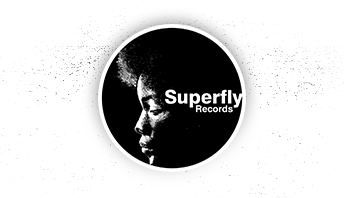


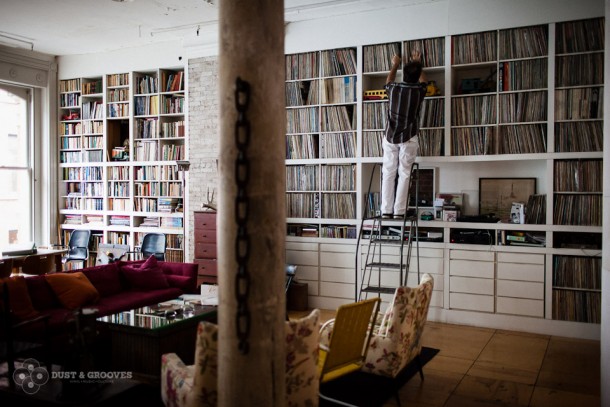
Each month, we are focusing on a record label founded by an active digger. This month, the Luaka Bop boss, long-time collaborator of Talking Heads David Byrne, is also a passionate record collector (check him in the Dust And Grooves book!) always happy to discover new music. Yale Evelev often stopped by the shop when he’s in Paris, mainly buying african LP’s. He took time to answer our questions about his label and his passion for records!
When did you start digging records?
Hmm, you know when I started there was no ‘digging’, that whole concept is sort of recent, well ‘sort of’ recent in a way. I started ‘collecting records’ at about age 8. I bought singles. Kevin Healy, my best friend, had an RCA 45 player with the fat post. My dad had a Garrard turntable that played 78’s and LPs and a mono tube system where you could select what playback curve you wanted!
My dad had LP’s from Memphis Slim, Big Bill Bronzy, Louis Armstrong, Pete Seeger, and some show tunes and the blue column Colombia Classical albums that were the first LP’s with record covers! He like music a lot but I don’t remember him ever buying a record, so these where ones he had before I was born, or when i was very young. In writing about it now it looks like a pretty nice range of things.
What Lps did you buy at first? Do you still listen to them?
First album I bought was Earth Opera, must of been around junior high school. There was a sale at Sam Goody’s in Phila, where I was from – so Sammy Grunber, Mark Bobrowitz, Mike Magen (rip) and I all went down there with the sale coupons ripped out of the newspaper. Earth Opera had an almost side long song against the Vietnam war, which everyone in my world was protesting about. By high school I was buying enough records that I had to hide the record bags when I came in the house so my parents wouldn’t see them.
Do you have a particular style or favorite period?
Ok here the meat of the issue and why I don’t really consider myself a ‘digger.’
I am an old motherfucker. I go through/have gone through different periods (many!!). In the beginning of high school I mostly listened and went to see acoustic blues. I saw Son House, Mance Lipscomp, Mississippi Fred McDowell, Bukka White, Brownie McGee and Sonny Terry, Furry Lewis, Speckled Red, Buddy Guy with Junior Wells, etc. I also saw rock bands that played blues who played at Phila’s Electric Factory, Canned Heat, John Mayall, Ten Years After, Jethro Tull, etc. And I was also into ‘Oldies’ so I’d go to Oldies shows and see Fats Domino, Little Richard, Chuck Berry, and others. There were also local bands I saw often because they played at street fairs in Phila. like The Nazz and Mandrake Memorial, and before them the Soul Survivors.
By the end of high school I was into Hound Dog Taylor and Eddie Harris’ “Listen Here” and John Klemmer “Waterfalls”. And then I got into the European art rock scene bands that were being played on the local radio station WXPN, and sold in Jerry Gordon’s 3rd Street Records; Faust, Can, Gong, Gentle Giant, Henry Cow, Soft Machine, Magma. And my jazz interest started to grow a bit as there was also a Jazz only station in Phila, WRTI, that played Calvin Keyes, Ahmed Jamal, Les McCann and Roy Ayers and that sort of thing, (I felt this stuff was most popular in Phila. because of this radio station).
I was of course buying albums this whole time, mostly from any store that was cheap! There was a store in Phila called Red Dot, that had big red dots on the records they sold which were almost all $2.99 cut outs. And then when 3rd Street opened, they would get a lot of promo stock from the local area record company promotion guys, who instead of getting records out to the radio and press, would bring a car trunk full of promos buy 3rd Street and Jerry would buy them and sell them for less then normal retail. I got all the Can records this way, plus many from the Black Jazz label, CTI things and so many others.
I moved to college in Boston (in the 1970’s!) with my collection of about 400 Blues, Jazz and art rock records. I had a good friend in college who was a jazz drummer, named Adam Nussbaum and I got a education from him on Jazz players like Booker Little, Wayne Shorter, Horace Silver. And I worked at a commercial radio station in, WBCN, so I got into the clubs Paul’s Mall and the Jazz Workshop for free. I saw; Rahsaan Roland Kirk, Charlie Mingus, Miles Davis (in a small club that was not full!), Herbie Hancock, McCoy Tyner, Elvin Jones, Gary Bartz, Pharoah Sanders (my favorite), Sonny Rollins, Hugh Masekela, BB King, Chico Hamilton, Taj Mahal, Mongo Santamaria, Muddy Waters, and Sun Ra! (who was living in Phila. so when I went back home I would buy El Saturn records that the Sun Ra band guys would bring by 3rd Street Records to sell.) Later I also got to go to Sunny’s house in West Phila.
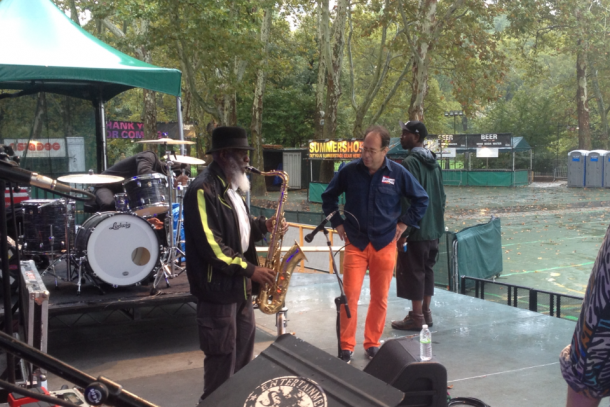
with Pharoah Sanders, as part of the Atomic Bomb shows, this one in Central Park, NYC (photo by Money Mark)
My college had an agreement with The School of Museum of Fine Arts, so I got to go there and take electronic music and video art classes. At art school I was exposed to Phil Glass who had made records on his own label, Chatham Sq., Steve Reich on DG, Terry Riley on Colombia (Poppy Nogood!) and Nonesuch Explorer series releases, like “Music from the Morning of the World.” During my college period I went to Morocco and had my eyes and ears opened by all kinds of music that was happening everywhere I looked. Snake charmer musicians who sounded like Coltrane, blind men in a row of four walking through the medina singing rounds, and lot’s of other things I don’t remember. What I do remember is that it taught me there was an amazing amount of great music in the world not just from Europe and America.
The end of college was the beginning of Punk, so friends formed bands like Human Sexual Response and the Sic Fucks. But I moved to NYC as a jazz person who also liked minimalism. (Luckily for me Phil Glass and Steve Reich played quite a bit with their ensembles in small NYC places with small audiences.) When I moved to NYC it was the end of the Loft Jazz scene. But I did get to see Don Cherry after he made the Brown Rice record at Rachid Ali’s club Ali’s Alley, (which was on the block I lived.) And I also saw the new generation of jazz players at that point; David Murray, James Blood Ulmer, Henry Threadgill, Ronald Shannon Jackson, Butch Morris, etc.
So, what was your job at this period?
I got a job in my local record store, the Soho Music Gallery. It was owned by the Boston mob who wanted to bootleg cutout records. As a cover story they distributed ethnographic recording labels, Ocora, Bärenreiter and Tikva (an Israeli Folk dance label). The basement was full of these albums that had been returned to the store, I got so many great records this way. The store was such an education. I was the buyer for all my interests; Jazz, World, Contemporary Classical, pretty much everything but rock. I was able to listen to every record in the store and learned about so much music that I was barely familiar with. I remember when the first while label I had ever seen came in the store, written on the cover in pencil was just the words “Dub Plate”. What the fuck? We listened to it and it sound like half the recording session was missing. We sold the three copies we had pretty much right away. We also had BYG albums by the Art Ensemble of Chicago, Chatham Sq records by Phil Glass, Richard Landry, Jon Gibson and Michael Snow. We had the Pyramids Records, we had a record of Gurdjieff playing Gurdjieff that his followers would stream in and buy, all the Jorge Ben albums on Philips, Strata East, Mbari, Black Artists Group, AkBa and all those small label jazz and new classical things people look for today were just new records easy to find in a bin. And I would spend a portion of my salary on records every week.
The store was a place that all kinds of people went to as it was quite large and had a very good selection. It was an in an arty neighborhood so lots of interesting people would come by like David Byrne, Brian Eno, Loren Mazzacane (who would just give us his records to give away as absolutely no one cared about him at the time), and artists like Mati Klarwein, Tony Conrad, Bryce Mardin and we hired musicians to work there like John Zorn, Anthony Coleman and even the actress Karen Jane Allen, (damn I was in love with her), before she was in many (or any?) movies.
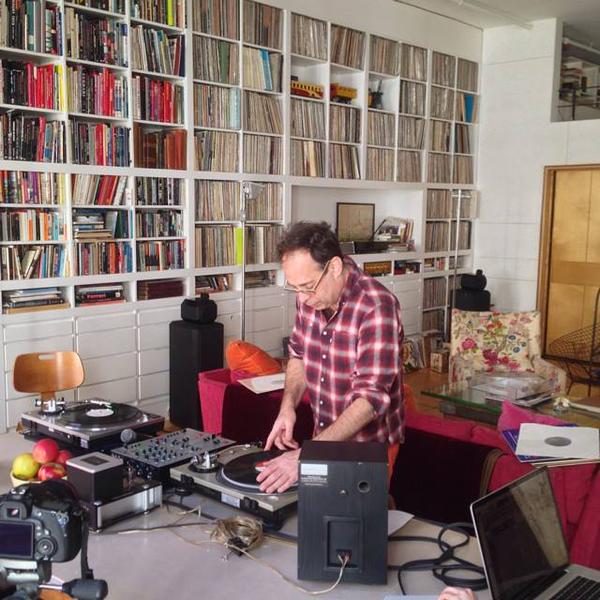
Shuggie Otis
Strawberry Letter 23
After work, Zorn had a little club under an aquatic pet store in the West Village that bands would use for rehearsals and small gigs, called Studio Henry. Zorn and Eugene Chadbourne, Wayne Horvitz, Christian Marclay, the Golden Palominos, and of course much more. There were also shows at a place called Soundscape where I saw Peter Brotzman and Han Bennick, Derick Baily, Marion Brown etc. And the Tin Palace where I saw a trio with Ronald Shannon Jackson, David Murray and Blood Ulmer, a sort of downtown jazz super group, put together to make big bucks on the European festival circuit. I was so excited to see this and so disappointed on how hollow it felt that I walked out and went half a block down the street to CBGB’s where the Ramones were playing and that had all the honesty and true emotion I was looking for.
After three years at the record store I left on a three months trip to South East Asia; Indonesia, India, Thailand, Burma, Malaysia… When I came back I got a job at the New Music Distribution Service, replacing Kip Hanrahan who was leaving to travel. New Music Distribution was started by Carla Bley and Michael Mantler to distribute a series of large ensemble jazz albums they had gotten funding for, on a label they created called J.C.O.A. They had convinced some New York musicians to play in each others ensembles so they could work with bigger bands. Along with Mike and Carla’s records there were releases by Don Cherry, Clifford Thornton, Roswell Rudd, Grachan Moncur and Leroy Jenkins. And in the JCOA Orchestra included Cecil Taylor, Pharoah Sanders, Gato Barbieri and many others. By the time I got to NMDS in 1980, JCOA was pretty dormant but we had an amazing catalog of every private press Jazz, contemporary classical and other non describable record you could ever think of – because that was the only thing we distributed, literally 2,000 artist produced records. All those ones that are so valuable now was because no one wanted them then. Of course this is where Soho Music Gallery got all those cool records as well. There might be one store in each major U.S. town that would buy from us.
What did you sale?
We sold records by the Residents, (and I met Homer and Hardy), Negativeland, (whose record covers were individually made of cut up Life Magazine pictures), Opus One label, (whose covers were printed in day glow inks), Beaver Harris’ 360 Degree Musical Experience, India Navigation (run by a lawyer for Western Union who let him build a studio in their building), Parachute (which had Zorn’s first records), Nels Cline & Vinny Golia had a label called 9Winds, Mother Mallard’s Portable Masterpiece Company, the U.S. Steel Cello Ensemble, and the Nihilist Spasm Band; labels; Titanic, Mission, Armageddon, Cold Blue, Wizard, Beep, Land Mammals, all the Bruce Haack albums and much more.
Some of my favorites were Harry Partch on CRI, Gary Wilson “You Think You Really Know Me”, Arthur Russell “Tower of Meaning,” Allan Bryant “Space Guitars”, Jon Gibson, John Bender “I Don’t Remember Now,” Michel Redolfi “Sonic Waters” I could go on and on. One day someone came in wanting to know if we knew anyone who would release a soundtrack to a movie that he had commissioned by Ornette Coleman. Hell yes, I would! So I started a record label of my own, ICON Records. Ornette came by work the next month. I thought he wanted to talk to me about the soundtrack, (the movie was called “Box Office”), but no – he wanted NMDS to release his unreleased tapes and pay him $50,000 a year. We didn’t have that kind of money and since he wasn’t happy with what I was paying the filmmaker for his soundtrack, that was the end of that. (As far as I know this album never came out.) But I had registered the label name, opened a bank account and for all intents and purposes started a record label.
So you could release other productions…
My first release was something I had heard in Indonesia in 1979, a small gamelan ensemble called Group Gapura. This did pretty well, I sold 8000 copies and it funded my label at the one release a year level that I was doing. My next album was by Daniel Lentz. And then I produced a record of John Zorn playing the music of Ennio Morricone called The Big Gundown. While working in the store with Zorn I had suggested we do this Morricone album and in 1985 he told me ok, let’s do it. The last album I produced never came out, it was Big John Patton, David Murray, Steve Nelson, Anthony Carillo and Bill Frisell arranged by Butch Morris. The record had issues because Patton had a drug problem and I had a drummer problem. First I hired drummer Lloyd Knibbs (from the Skatalites), but that wasn’t working out. Then I did another session with Ignacio Berroa on drums and George Freeman on guitar but that wasn’t working out either, and then Patton’s dealer slashed his right arm ending the whole project, (and the label, as all the money I had to make records came as each one supported the next one).
I had about 10,000 records by this point, with different periods of my life lending themselves to different focus. While at the record store some guy would come in and buy African ethnographic records. He was always talking about how James Brown was directly related to the African music we liked and said there was a Sam Goody remainder store in the westside who had all the James Brown King records, new, sealed, cheap. Bam! I also went with Zorn up to 125th street where stores had zillions of copies of Maceo Parker records as well as JB records on People, because no one wanted them. I went to the New Orleans Jazz and Heritage Festival and saw Bobby Blue Bland which got me totally into that style of soul music. I got into dub records, Chutneys (from Trinidad), surf music, Derrick May and the Detroit electro thing, Googie Rene, Frankie Stein, John Cage (who I got to meet), tons and tons of Latin Music as NYC was a center for that. And of course more and more and more. Each part of my life represented by a new music interest and exploration.
I was At NMDS for eight years and it was always a struggle for us. When our fund raiser Taylor Storer got cancer in his 20’s and died over a three year period, Michael Mantler and I hired a South African guy named John Baskind to replace him, everything quickly started to go south. Of course this was the beginning of the end of the first LP era, so all the stores started returning LPs instead of paying for them. I fought a lot with Baskind and saw the writing on the wall format wise and left.
At this point my wife, who was an architect, had her cousin build us a wall shelving unit for the books and records which had been in crates stacked on the floor. She asked if I wanted anything to hold CD’s and I said no I hate CD’s!, I’ll never buy those. I was wrong and that was near the end of me buying vinyl for the most part.
Jorge Ben
Ponta de Lanca Africano Umbabarauma
What’s hapenning?
In 1989 I got a job at The Brooklyn Academy of Music where I programmed; Cachao, David Lynch’s Industrial Symphony, The Butthole Surfers, Negativeland, Pete Cosey, The World Saxophone Quartet and 500 others including Moondog!! (in his first concert back in NYC since he had left for Germany). All this happened in one 10 day period in NYC for a festival called New Music America. When that was over I left BAM and David Byrne hired me to run Luaka Bop.
I guess I don’t think I’m a digger, because I didn’t have to dig. I bought much of this shit new!
Are you still buying vinyl, visiting record shops?
In a word, no! But as I just spent $700 in your store perhaps I shouldn’t be believed when I say that. I try never to buy records in NYC where I live. Only when I travel, I don’t want more records! But If I am in another country I feel – I’ll never see this record again I better buy it now.
What was the first release on Luaka Bop?
“Beleza Tropical”, which came out in 1989.
Why did you choose this name: Luaka Bop?
David choose it, probably because he liked the sound of it. It was a Sri Lankan tea he found in the UK.
What could be the label’s leitmotif?
Perhaps someone else would better at this question then me. Someone once said we were wonderfully impure. I guess we always want to be surprising, not do the same types of music, not exist in any genre or be part of any scene. In fact we don’t expect as a label to have any fans. It’s not that people don’t like what we do, but they should feel they might not understand the record that comes out after the one they loved.
What is the role of David Byrne in the label? Does he still suggest compilations ideas? Doest he still dig LPs?
He doesn’t, in 2003 he decided that he had enough of having a record label so I have run it without him ever since.
How do you decide on the choice of reissues?
No idea, there isn’t really a set way to answer this. Anything that fits within what we like as a label, I guess. That’s not really an answer I don’t feel.
Luaka Bop is well known for his ability to rediscover forgotten artists : from Tom Ze to William Onyeabor, from Tim Maia to Silvio Rodriguez, what is the reissue your are prouder?
Hmmm, certainly the Onyeabor was such a surprise in terms as how well it did, and the fact that we got to work with his entire recorded output is amazing. Tom Ze is super important to me because we were able to rescue him from oblivion in Brazil. And he is so worthy as a musician and a person who has now gone on to become an important part of the Brazilian music scene.
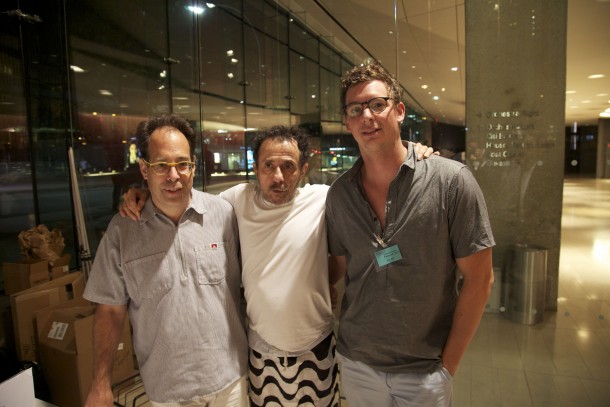
With the great Tom Ze
Tom Ze
Mae Mae Solteira
What about your serie titled World Psychedelic Classics ? Any new for the future ?
We started that with Os Mutantes. The whole idea that there were Psych bands from places other the the U.S. and the U.K. was not something most people had ever considered. We wanted to challenge peoples preconceptions. At that time it surprised a lot of people in a way that is almost inconceivable today. No idea what the future holds for this series.
While Luaka Bop was more established for compilations in the 90’s and 00’s (from Black Peru to New sounds from NorthEast Brazil), since few years, there were less compilations. Is it an artistic decision? or is it a realistic choice because this part of the market is now really « over » covered?
Both, David started the label doing compilations, and though I did a few, “African Psych: Funky Fuzzy Sounds of West Africa”, “Telling Stories to the Sea” (the Portuguese African one), and for the most part the Black Peru one, the compilations were really his thing. Nowadays I’m just not as interested in doing them; the hellish negotiations that take forever, and competing with the internet, which is a societal compilation.
These days you seems like buying a lot of african records. Is it a new thing or have you always been into african music?
Yes I have always been into African music and at the same time it’s a new thing. Because when I was into African music before I could only buy the records I found in NYC, or somewhere in the U.S., or in a store in London or Paris, which were not so many compared to now. When you guys are bringing in so many records and collectors are buying up everything that moves, there are so many great records available now, it’s blowing me away.
When I worked at the record store, John Zorn and I used to go to the African Record Center in Brooklyn on Nostrand and buy records they would import for the store, they also had their own label too, Makossa Records, (were those all legally released?). My small collection of African Funk stuff I mostly got from them and I used that to make our Funky Fuzzy compilation. Since I bought every album of this type of thing I could find I had no idea that years later so many bands playing this sort of music existed! As much as you think you know about something it’s so great to realize you don’t know shit! The beauty of being into music and records is that there is always something new to learn about, to be moved by. Much as my record collection is a personal history, it’s not static, or frozen in time. Of course these days I have no more shelf space!
Ofo & The Black Company
Allah Wakbarr
Long time ago, you released a fabulous record of Waldemar Bastos… Any news of the great voice from Angola ?
We did one record with Waldemar, David asked Arto Lindsay to produce it. He recorded with his band of lead guitar, bass, percussion and drums. When he came back to NYC to pay a week of shows in one venue, he had a different guitar player from Guinea Bissau who was incredible. The shows were amazing, each night building from the last and so fulfilling to have experienced. At the end of the week I said to Waldemar, we really have to do your next record centered around the new guitar player. He fired him the next day. We never did another Waldemar record (not because of that). I have tried to figure out who that guitar player was to this day. I bought so many Guinea Bissau records from you last time I was there, always thinking that a guitar player on one of them must be that guy!
Another part of your catalog is dedicated to new talents, as Kings Of Forth, Javelin or +2 project (Kassin, Moreno, Domenico)… How do you find brand new talents? On the internet? On stage? Through friends?
The last way, almost always through friends.
And who is the next?
Floating Points & Doug Hream Blunt…
What is the best deal/business: to make reissues or to produce/coproduce new records?
Hard to answer this. I will say when you release something that is already recorded, you are getting to pick something you know you really like. New recordings are so much riskier because they often as not, don’t turn out as perfectly as a reissue chosen from someone’s complete recorded history. So if you make a new album that isn’t what it should or could be you have to continue to spend money to make it better, unlike a compilation with fixed costs.
What do you think about the brand new fashion of vinyle ? Only fashion or a real and long term tendency ?
I thought it would fade, but it hasn’t. So what can I say?! And now that Apple has taken the cd drives out of all their computers, and streaming is catching on with more and more people perhaps the LP will be the only hard format, perhaps. Maybe CD’s will come back too? I never thought the LP would come back and the fact I have a wall of them is because I realized its in a way an audio journal for me and my collection serves as a piece, if you will. I didn’t make the records but I spent my life assembling them. The LP seems to lend itself to that sort of viewpoint, not sure the same can be said for a file.
Have you received many negative answers on some of the LPs, artists, unreleased tapes, you were trying to reissue?
Hmm, there was a Japanese album I was trying to do that just seemed too difficult and three times I have tried to do a Jorge Ben album but each time it started and then, stopped.
What are your next releases ?
There are two albums we know about right now and the artists are about as different from each other as could be: the first is by Doug Hream Blunt: “My Name is: Featuring the Hit Gentle Persuasion”. Doug learned to play music at the age of 35, by taking an adult education class in the late 1980s. The class was organized by a high school music teacher and his wife, and held in their small garage in the Golden Gate Park neighborhood of San Francisco. The other students of the class became Doug’s band members and they recorded a record of Doug’s music, with the teacher on drums and vibes, and the teachers wife on bass. To promote his music, Doug would play acoustic, solo shows for patients and elderly people at a hospital where he worked as a nurse’s aid. On a few occasions, he also brought the other students together to play on the City Visions Public Access television show in San Francisco.
The second is from Sam Shepherd under his artist name Floating Points with an album called “Elaenia”. As unknown as Doug is Sam is somewhat known, as unschooled as Doug is Sam is very schooled in classical and jazz (with a doctorate in neuro science). “Elaenia” is a dazzling score which puts Sam Shepherd in the spotlight as a composer who has produced an album that bridges the gap between his rapturous dance music and formative classical roots that draws upon everything Sam has done to date. He has made it over the last five years and recorded it in his own studio with an ensemble of 11 people.
There is actually a third album we know about as well, some time next year we will release our second album by Sierra Leonian musician Janka Nabay.
What is the LP you dream of reissuing?
We still want to do more with Tim Maia. The situation though is quite difficult.
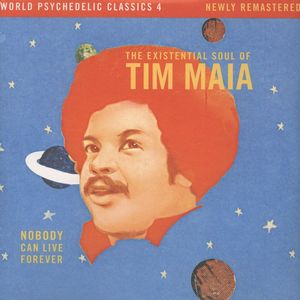
Tim Maia
Quer Queira Quer Na 0 Queira